Outdoor Living Areas
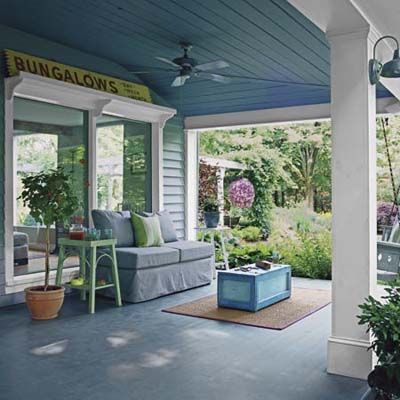
Most yards consist of a lawn, with a smattering of shrubs and flowers. You mow, you weed, you prune, and you admire your handiwork on your way to the mailbox, but otherwise your landscape may not see much action. Yet by thinking of the spaces outside your house the same way you think about the ones inside, you can transform your property with versatile outdoor living areas that draw family members and friends to all points near (the front porch) and far (the back fence).
Bruce Littlefield

Case in point is the outdoor space around this 1920s farmhouse in the Catskill Mountains of upper New York, owned by Bruce Littlefield. When he bought the place in 1999, it was so overgrown with brush and poison ivy that it took the whole summer to clear it. The author of several lifestyle books about decorating inside and out with vintage finds—including the recent Garage Sale America—Bruce envisioned his property as a series of open-air rooms centered on a different activity or landscape feature. “I figured I could double the size of my house and the number of people I could have over by adding rooms outdoors,” he says.
Furnish a porch, deck, or patio like a living room
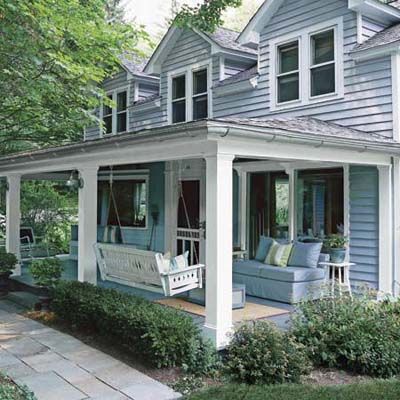
The furniture on most porches backs up against the house, which is fine as an observation post or a place to read the paper, but it’s not the best setup for socializing.
What was done here: When Bruce designed the front porch addition to his farmhouse, he made it a generous 12 feet deep, instead of the usual 8, to fit extra furniture. He also added electrical outlets for plugging in table lamps and recharging his laptop. To make the most of his space, Bruce planted boxwoods around the low-slung porch’s three open sides, rather than ringing it with railings. This increased the usable floor space and allowed him to hang a vintage swing, which he faced toward the sofa that sits against the house. Streamlined furniture, such as an armless, weatherproof sofa, petite metal chairs, and painted wood tables—all found at yard sales or on eBay—expand the space even further.
More take-home tips: On a back deck or patio, create different furniture groupings based on the activities you want to have happen there. For instance, a large, all-weather table and chairs in the center can easily accommodate a family barbecue, while benches along the perimeter will encourage private party conversation.
Create a feeling of enclosure—and some shade—with an overhead structure
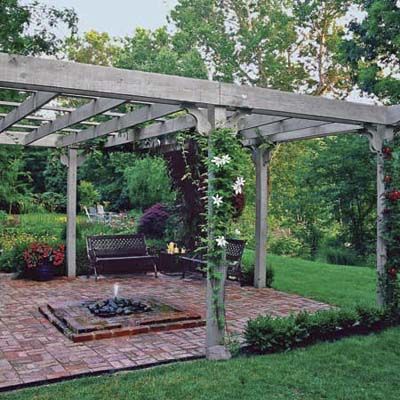
A little cover from the hot sun
will make an outdoor room more comfortable, but that doesn’t mean you need a solid roof.
What was done here: Building this vine-covered pergola over the patio casts a pleasant dappled light on the recycled bricks—and any seated occupants—below. Bruce’s garden designer, Tim Cleary, used pressure-treated 6×6 posts to support a grid of 2×10 beams and 2×6 rafters fastened with through bolts. The beefy construction was required for the American wisteria that Mary Cleary, Tim’s wife and business partner, trained up the posts. Otherwise, the thick, twining vine, which grows quickly but can take years to flower, will pull apart nailed boards and crack small ones. Mary also planted clematis to cover the posts with summer blooms. (For more vines, see the list on slide 11.)
More take-home tips: A retractable fabric awning off the side of your house or a patio umbrella can also provide cover, keeping diners and loungers from baking in the heat. Outsize and cantilevered umbrellas can shade most of a small terrace or deck. (Giant Umbrella Company and All American Pool and Patio offer a look at some of the latest.)
Know-how: Making a strong, stylish pergola
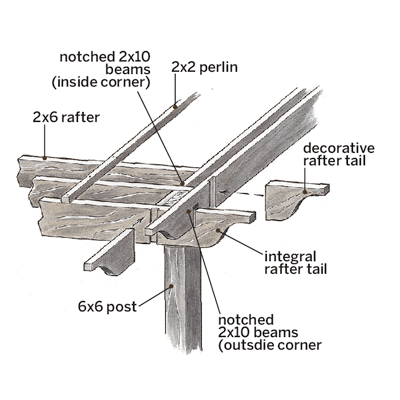
A good part of the detail on the freestanding pergola shown in slide 4, and much of its stability, are found in its four corners, where the tops of the posts are wrapped with two sets of interlocking beams that have rafter tails. Here, David Valcovic of Trellis Structures—This Old House landscape contractor Roger Cook’s go-to guy for custom pergolas—shows how to make this long-lasting connection:
1. Where beams cross on the outside corner of the post, notch them about halfway through—one from the top, the other from the bottom—so they fit together with the tops flush.
2. For beams that meet at the inside corner of the post, cut off the rafter tails to the same length as the ones extending off the first set of beams. Notch beams halfway through where they meet at the post’s inside corner; they should fit together with the tops flush.
3. Route ½-inch-deep slots in the outside faces of the first set of beams to accept the second set’s decorative rafter tail pieces; this will keep them from visibly pulling away when the temperature changes. Glue and screw the pieces in place. —SAL VAGLICA
Use a water feature to draw people out into the yard
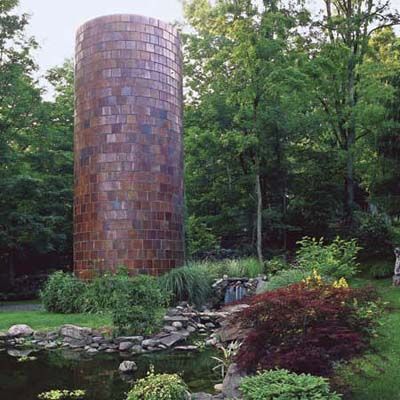
Build a fish pond or place a birdbath or gurgling fountain near your property line to bring family and guests out for a visit, maximizing every inch of your green space.
What was done here: The large boulders arrayed around Bruce’s pond provide sturdy, impromptu seating. There’s no need to lug chairs out to the water’s edge to watch the koi, turtles, and frogs. When planning a pond of your own, avoid putting it under a cluster of trees. “You don’t want to spend all your time cleaning leaves and debris out of the water,” Bruce says.
More take-home tips: You can create a simple focal point with a fountain. All you need is a submersible recirculating pump, something for the water to pour over—such as a stack of river
rocks—and a basin to catch the overflow so it can be funneled back (check out the pebble fountain on Bruce’s patio, in slide 4). A fountain helps drown out noise from neighbors and car traffic.
Just be sure there’s a spigot and a GFCI outlet nearby for refilling evaporated water
and running the pump.
Use low walls and a floor to establish the room’s footprint

An outdoor room can be located almost anywhere in your yard, but there are a few guidelines for creating one. They typically require some sort of floor, such as crushed stone, brick pavers, or even a patch of steppable ground cover. You’ll also need walls: A simple hedgerow, picket fence, or adjoining trellises can create a boundary.
What was done here: The remains of the 5-foot stone foundation Bruce found on his property are tall enough to provide a sense of enclosure but not so high that you can’t peek over them and take in the view. Working with Tim Cleary, he laid a bed of pea gravel to form a stone floor, then outfitted the space with a table and chairs and a bar cart for an outdoor dining and entertaining room.
More take-home tips: You could build your own sitting wall of mortared stacked stone. At just 17 or 18 inches high and 1 to 1½ feet deep, topped with flat capstones, it easily doubles as a bench.
For a planted border, consider evergreens such as boxwood, holly, or privet. All-season greenery will help define the space and prevent the spread of loose gravel into the grass—and vice versa. Choose dwarf varieties to keep pruning to a minimum.
Know-how: Building a gravel patio
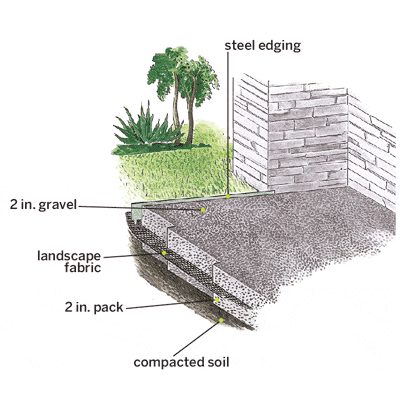
Laying a crushed stone floor is one of the easiest ways to increase outdoor living space, says TOH‘s Roger Cook, who suggests using locally sourced stone to minimize transportation costs and your carbon footprint. Here’s his step-by-step:
1. Mark the patio’s borders with spray paint and excavate 4 inches of soil within those lines using a square-head shovel. Compact the remaining soil with a hand tamper.
2. Fill the excavated area with 2½ inches of pack—a mix of 3/4-inch crushed stone and stone dust—and rake it level before tamping into a smooth 2-inch-deep slab.
3. Lay landscape fabric over the base and sink steel edging along its perimeter. Use a wood block and hammer to tap the edging down until it’s level with existing grade. The edging spikes should puncture the landscape fabric to secure it in place.
4. Shovel gravel on top of the fabric until the patio’s evenly raked surface is ½ inch below the top of the edging. —SAL VAGLICA
Take advantage of outbuildings
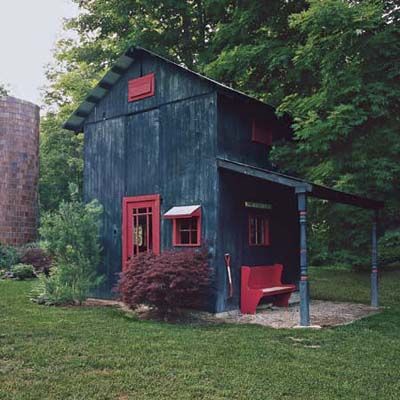
Your yard may already contain features that can anchor an outdoor room.
The exterior wall of a detached garage,
a toolshed, or a storage barn are ideal starting points.
What was done here: Rather than tear down this dilapidated outbuilding, Bruce shored up and spruced up the structure as the backdrop for a covered seating area.
He retained the building’s vintage character by using corrugated metal roofing and vertical plank siding finished
in charcoal paint, giving the boards a weathered look. He used a bold red on the divided-light door, awning-covered window, and trim boards to set off the structure’s details. He then added a Japanese maple and an ornamental pine, foundation plantings worthy of a house.
For the seating area itself, he laid a
pea gravel floor and built a shed roof overhead using rough-cut 2x4s from a local mill, more corrugated metal for the roof, and two Victorian-era porch posts that he picked up at a yard sale and painted to match.
More take-home tips: To gussy up a garage or shed, attach wood lattice on a sidewall for climbing roses to grow up, put up a flower box beneath a window, and arrange a pair of Adirondack chairs or a bench in front of it for an outdoor reading nook that’s sheltered—at least on one side—from the wind.
Add a hearth for an instant gathering place, day or night

Fire turns any spot in the yard into an attraction where people can keep warm and admire the flames on a cool night, much as they would in a living room with a fireplace.
What was done here: A
stone-ringed pit makes a patch of grass near Bruce’s front porch an enticing daytime destination. A die-hard flea marketer, Bruce has a collection of secondhand chairs to put out. But he prefers a simple moisture-resistant cloth. “The best picnic blankets are those quilted moving blankets from the U-Haul store,” says Bruce.
More take-home tips: If your outdoor room is a ground-level patio, consider adding a masonry fireplace or buying a prefab one. You can get a large freestanding model sheathed in faux stone veneer for $500, while a more elaborate fireplace with a copper chimney cap and tabletop-height pillars on either side goes for $1,000 (both at Sears). Most store-bought hearths burn logs, but some run on natural gas or propane and can be plumbed into your home’s fuel line, just like a gas grill.
Types of Decorative Gravel to Consider

1. Pea Gravel: Usually sandy in color, inexpensive, and easy on bare feet
2. River Rock: Smooth
stones extracted from riverbeds in a variety of colors, often grays
3. Lava Rock: A very lightweight, red-ochre-colored pebble with angular edges
4. Quartzite: Similar to pea gravel but with a brighter, whiter color
